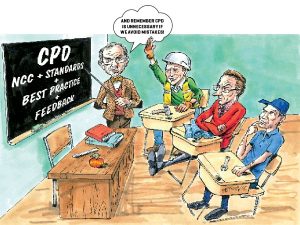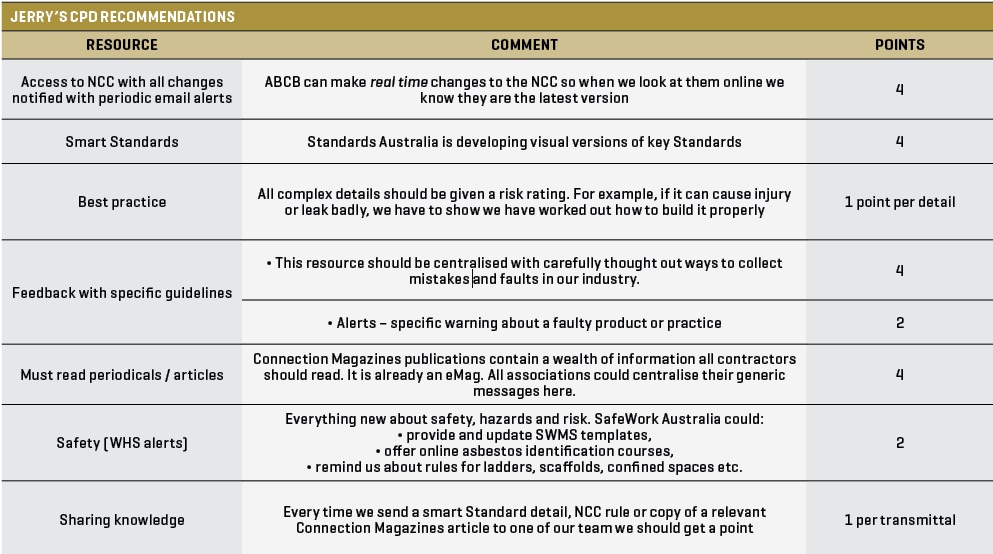CPD – Continuing Professional Dumbness
Jerry Tyrrell argues that there is a better way for all of us to keep up-to-date and learn new skills.

You all know I’m a fan of education and knowledge. I write this column every quarter and try to share everything I’ve learnt over 46 years in our industry. The industry wants us to keep learning too. Every year we spend hundreds of millions of dollars on continuing professional education (CPD).
Some of this money is well spent. But too often it is wasted. These are some of the reasons why:
- course content that does not help us
- information is poorly presented
- we have no way to easily access/apply the information we are given at the course
- our industry has no effective way to tell us about mistakes we are always making
- disinterest from us.
CPD is aimed at keeping us up-to-date with products and practices in our industry. But like most good intentions in our industry, it has not been carefully thought out.
Nor does it realise we all have different learning styles and most of us hate classrooms and people who use too many words and too few clear images. I am an architect, designer, builder and tradesman. So I’m going to be cheeky and speak for all of us.
After speaking to thousands of tradespeople and professionals, I reckon the things we all want advice on are:
- where to find best practice
- how to use the NCC… not just here about
- what Standard to use and how to get it quickly… at NO COST please
- what has gone wrong in the past year
- how to fix mistakes we never wanted to make.
The Australian Building Codes Board (ABCB) is working hard to get the NCC right. It is moving with us and starting to develop tools and resources that give us what we want. It is providing pictograms for the 10 Classes of Buildings, number of toilets in a large commercial building and the right terrain category for the postcode of our building.
Well, I may have lied about the latter. The ABCB is not doing this last one yet.
Most importantly though, the ABCB is working with Standards Australia to provide us with a single dictionary of building terms. Yippee! Architects, certifiers, contractors and tradespeople will finally use the same language.
We could get points automatically
The CPD we all want encompasses curiosity, constant relevant intel from Standards and the ABCB, as well as written summaries we can easily find and read. And CPD should include alerts about chronic failures and mistakes.
For instance, we should be rewarded when we read this magazine. We should be rewarded every time the HIA or MBA send out an alert about the stupidity of using composite flooring next to a pool, external doors with MDF cores, plasterboard when repairing a flood damaged basement, jambs embedded into tiles… but no. The associations are not doing this yet.
We should be rewarded every time we check the correct way to waterproof a weather exposed sliding door. This could easily be set up with the new smart detail Standards Australia is developing.
AI (artificial intelligence)
If we get CPD points for using the right resource, I think we should use AI to record and tell our associations. The industry could easily set this up.
It could be supported by every association, institute, licensing authority, state and federal government. If you read it, research it, download, transmit it, check with your network of experts, review an approved source on your tablet or smart phone, this should be recognised and count towards your CPD.
When you meet the architect, waterproofer and tiler on site to nut out a complex sunken bath with fountain and koi pond on the other side of the wall, you should record this and get CPD points.
We’re all privy to the notion of frequent flyer points accumulating every time you fly. Why can’t our CPD Points accumulate every time we are smart?
The CPD we all need
The following is the ‘blend’ of what we should have. It should all be on our tablets or smart phones. Download is proof that we have complied. And all contractors should know that if anything goes wrong, their work and decisions will be assessed against these rules and resources. This information must be properly prepared though. It needs to be summarised, illustrated and displayed in point form. Complex processes should be supported by a video.
This is a chance for organisations and the government to coordinate and fractionalise the cost of these resources. Most importantly, they can implement an enduring system that we will use. This solution is cheaper, recoverable, relevant and no nonsense.

Sadly, most CPD in industry is falling on ‘deaf ears’. Accumulation of CPD points should be valued. All of us should look at our points ‘calculator’ and remember what we learnt and see long term benefits in the reduction in mistakes, complaint and post completion stress.
NCC is now free. Standards will soon be smarter and easier to access. Associations will become irrelevant unless they provide real benefit that helps us build better. Governments need to invest in ideas that support us. They need to be proactive, rather than reactive too. I’d say 90% of the cases I’ve been involved in were easily preventable via better knowledge/CPD.
Finally, I learnt so much about building from the many craftspeople I have laboured for, worked with or collaborated with on complex details. They are marvellous sources of CPD. You can be too.
